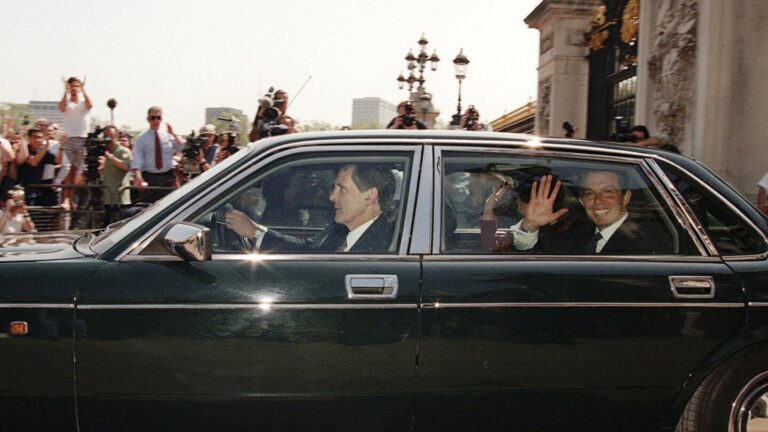LONDON (AP) — The Labour Party won the UK general electionbringing a new party to power for the first time in 14 years. But Labour leader Keir Starmer will not actually become prime minister until a carefully orchestrated ceremony on Friday in which King Charles III formally asks him to form a new government.
It is a moment that embodies the fact that, technically at least, the right to govern In the United Kingdom, political power is still vested in the royal authority, centuries after real political power was transferred to elected members of Parliament.
THE the process is fasteven if it is a bit brutal for the departure of the Prime Minister Rishi SunakHere’s how the ceremonial events will take place.
History meets the modern world
Britain is a constitutional monarchy where the king’s power is strictly limited by law and tradition. Yet much of what happens here harks back to the past. In this case, the process harks back to a time when the king exercised supreme power and chose his preeminent minister, the prime minister, to lead his government.
Today, the prime minister is the leader of the party that holds the majority in the House of Commons, but technically the job still has to be offered to him by the monarch, said Anna Whitelock, professor of the history of the monarchy at City University London.
“It reflects our historical past and it reflects the fact that we have a constitutional monarchy, a parliamentary democracy, and so the prime minister and the monarch work hand in hand,” she said. “They both have a key role in the Constitution. And we see that come to fruition the day a prime minister officially takes office.”
What’s going on at the palace?
More than 50 countries will go to the polls in 2024
First, Sunak will travel to Buckingham Palace to present his resignation to the king. Starmer will arrive for his first audience with Charles.
“There is a small window between the departure of the prime minister and the formal appointment of the new one, where technically the power resides for those few minutes in the hands of the monarch,” Whitelock said. “So there is a brief moment where there is effectively a kind of vacuum in terms of parliamentary democracy. … But, of course, there is immediately that moment when the new prime minister is appointed.”
This happens when the future prime minister enters the palace for a ceremony known as the “kissing of hands”, although no actual kissing takes place. After the king asks Starmer to form a government, he will bow and shake Charles’ hand. A photo will be taken to record the moment of the transfer of power.
While there will be no record of the exchanges between the monarch and the prime minister, there will be spectacular activity outside the palace gates. Helicopters will follow Starmer and Sunak’s cars to the palace and back. Commentators will typically excitedly record their progress and speculate about what is being said behind closed doors.
Traditionally, the new Prime Minister then leaves the Palace in a Prime Minister’s car and returns to Downing Street to make a statement, receiving applause from staff as he walks through the famous black door of Number 10 and begins government business.
And Sunak?
In Britain, the voters’ verdict comes quickly.
After suffering a brutal election defeat, Sunak will be forced to leave the prime minister’s official residence before Starmer arrives hours later.
The future ex-prime minister will be driven to the palace in a ministerial car with a driver. But after submitting his resignation, he will leave in a private vehicle and return to his private residence.
The transition is so rapid that the outgoing leader’s removal van is usually somewhere near the back door of Downing Street while the new leader waves at the front.
Why is the ceremony important?
The entire royal choreography shows, if nothing else, that the monarchy remains a symbol of stability and continuity at a time when deep divisions within society are sparking heated political debate. The king, who stands above the political fray, nevertheless directs the show – albeit in a ceremonial manner – and will continue to do so even after the prime minister leaves office.
“Everyone will say, ‘Well, this is all ceremonial,’ but it’s a very important aspect of the fact that governments can change in the UK, and we don’t riot,” said George Gross, a royal expert at King’s College London. “Maybe it didn’t need to be said before, but in the context of the current political world and geopolitics, I think it’s really healthy.”
In her 70-year reign, Queen Elizabeth II has been served by 15 prime ministers. Charles, who has been on the throne for less than two years, now welcomes his second.
“This is the pinnacle of power,” Gross said. “Ultimately, the monarchy is about continuity and prime ministers come and go.”
What happens next?
The King meets the Prime Minister every week to discuss government matters. Although the monarch is politically neutral, he has the right to “advise and warn” the Prime Minister if he deems it necessary. These meetings are private and the matters discussed remain confidential.
The king will return to the public stage later this month for his next major royal event: the State Opening of Parliament.
Traditionally, the monarch arrives in a horse-drawn carriage, sits on the Sovereign Throne in the House of Lords and wears the Imperial State Crown.
Then, at a joint meeting of the House of Lords and the House of Commons, he will deliver a speech written for him by the new government to set out its legislative programme.
It is a moment of pomp, true, but it perfectly illustrates the role of the monarchy in modern Britain.
___
Associated Press researcher Rhonda Shafner in New York contributed to this report.
___
Follow AP’s coverage of elections around the world: https://apnews.com/hub/global-elections/


